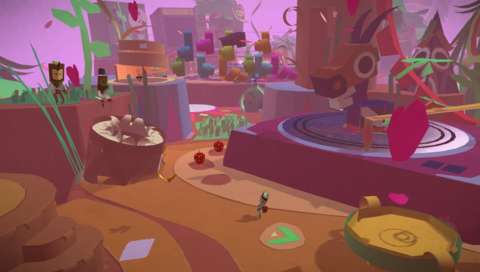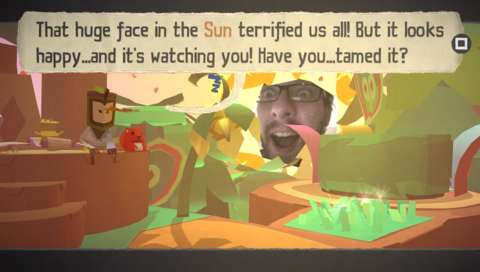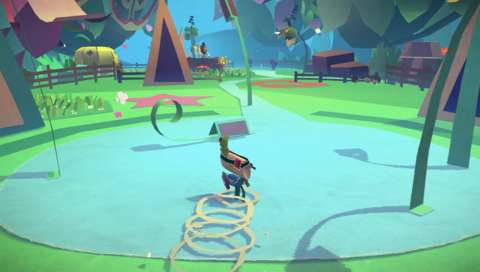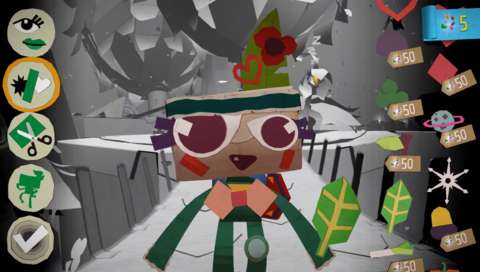Tearaway is about blending the real and digital worlds, pulling down the boundaries that separate us from what we're playing. To that end, you're not just a gamer when you're playing Tearaway; you're a godlike presence, representing both the ultimate goal and the protagonist.
In essence, then, you play two roles. One of those roles is as a sentient envelope on a mission. Your first decision is to take the reins of either the male envelope Iota or the female envelope Atoi. (Note the playful spelling trick.) Iota or Atoi becomes the protagonist, the driving force behind the narrative and the personality that other characters interact with. No matter which one you choose, the end goal is the same. Reach the sun--that's all you have to do. The twist is that the sun is you. Yes, you, the player.

Through the magic of the PS Vita's front camera, your face appears within the outline of the sun and becomes the visual embodiment of the second of your two roles. You smile; sun smiles. You frown; sun frowns. You point your Vita at your dog; sun becomes a dog. An ugly visage (in your case, perhaps less ugly) intruding and bearing down on the papercraft environment causes a bit of an understandable stir, so Iota (or Atoi) sets out to find the meaning behind and origin of the thing from another world.
And thus begins an adventure of surprising depth given the paper-thin building blocks. The immediate pull of Tearaway is the quality and charm of the visuals, sucking you in to what is a traditional 3D platformer at heart. Every element used to create every level, character, and collectible could realistically be made for real with only coloured paper, scissors, and a stick of glue. Not only is this playful aesthetic inviting, but it fundamentally enhances the link between the digital and the real.

Much of what is present can be customised to suit your own tastes and mood. Some form of customisation was always to be expected given developer Media Molecule's Little Big Planet roots, but the approach here is very different. While the Sackboy experience concentrated on the large-scale creation of worlds and even entire game experiences, Tearaway takes the approach of letting you customise rather than build. Your hero's appearance, for example, can be altered as frequently and as wildly as you like. This can be achieved using either the preset shapes or the virtual paper-cutting tools that allow you to design your own elements from scratch, layering sheets of coloured paper to create more complex and more colourful objects. Additionally, you're frequently asked to design the look of many of the game's more important items and lead characters.
Every form of interaction is executed with skill and expert pacing, and never does one element outstay its welcome.
One early section sees you riding an energetic pig through a valley--an everyday task for many, I'm sure, apart from the fact that the pig can be altered before you start. Give it four eyes, a Santa Claus beard, and an oversized crown of gold and gems, or simply give it fangs. A hedonist pig... a vamporker... nothing is out of bounds. Remember that you're not just the protagonist; you're the god of this world, and a pig will look how you want it to look. Your all-powerful status extends to gameplay that makes full and excellent use of the Vita's unique features. Many past Vita games have failed to implement the handheld's touch capabilities and tilt functions in any meaningful way. Thankfully, Tearaway never feels gimmicky or anything less than an excellent example of incorporated design.

Like the visuals, the touch and tilt controls only serve to more thoroughly break down the barriers between our world and that of our handicraft hero. Tapping on the rear touchpad allows you to poke virtual fingers through certain parts of the world, which is great for dispatching enemies and moving obstacles too large for Iota and Atoi to move with their flimsy paper-thin bodies. The front screen can be used to pull parts of the scenery apart in a bid to unlock hidden areas or unroll paper to create bridges across gaps and over obstacles, while specific enemy types also require front screen interaction for you to to finish them off completely. Both front and rear cameras are used regularly to distinguish your world from that of other Tearaway players, while the gyroscopic tilt functions are reserved for slightly (very slightly) more challenging sequences later in the game.
Every form of interaction is executed with skill and expert pacing, and never does one element outstay its welcome or feel as though it takes away from the onscreen action. The mere fact that the controls feel normal is evidence enough that, when done right, each and every one of the Vita's features can be used in tandem and as a means to elevate gameplay. The traditional input combination of buttons and sticks allow for a set of basic and intuitive movements and actions. There's nothing here that rocks the 3D platformer boat, with jump, roll, pick up, and throw all present and accounted for. It's impossible to be cynical about the limited range of motions, however, given the overwhelming cute factor exuded by the aesthetic and the touch controls.

It's easier to be cynical about other aspects, though. While Tearaway's levels are the ideal length for a handheld game (none take longer than 15 to 20 minutes), there are simply not enough of them to keep you entertained for long. A couple of extended play sessions is enough to finish a complete playthrough. Hunting out all of the hidden collectibles and photographing points of interest give you reasons to return, but there's nothing on offer that is especially taxing, and you will probably find the vast majority of items with relative ease.
Tearaway's most lasting feature is not within the game itself, but through the inclusion of printable blueprints. Through standard progression and by taking photographs of certain objects, you earn blueprints that allow you to create your own origami editions of your favourite elements from within the game. Be warned, though, that even when you follow the instructions, some of these are incredibly tricky propositions, but if you've got the patience, it's worth the effort to take the theme of connecting worlds to that next step. The fact that it's so tempting to spend time creating these paper models is a testament to how appealing and attractive Tearaway is. It's just a shame that one of the Vita's best experiences feels as long as a piece of paper is thick.